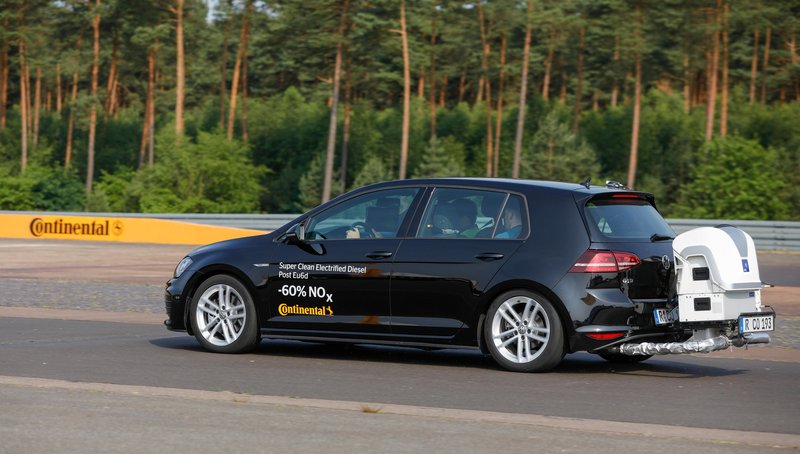Clean and Efficient: Continental Shows How to Combine Lower Emissions with Reduced Fuel Consumption
- Continental technology packages open the way for super-clean- and CO2-efficient – hybrids
- Continental demonstrates that fuel-efficient diesel engines are capable of achieving real-driving NOx emissions below 35 mg/km, with simultaneous reductions of up to 10 g/km in CO2 emissions
- Combined with optimized injection, 48V hybridization also enhances gasoline particulate filter regeneration
Regensburg, Aachen, October 8, 2018. Long before EVs establish themselves as the dominant vehicle technology, electrification has the power to make a big contribution to clean urban mobility. At the 27th Aachen Colloquium (October 8-10), Continental will demonstrate to leading industry experts how 48V hybrid technology can be used to deliver reduced nitrogen oxide (NOx) emissions for both diesel and gasoline engines. Continental’s approach combines engine-integrated technology packages with electrically assisted exhaust aftertreatment functions. These new functions, powered by the additional electrical energy generated by a 48V hybrid vehicle, open the way for further advances in both emissions and fuel consumption.
For the beleaguered diesel engine, for example, such measures are more urgent than ever before. Can a way be found to allow drivers to continue using diesel engines without leading to excessive NOx pollution in towns and cities? A Continental demonstration, performed under real-world driving conditions, shows that it can: The NOx emissions of the second-generation “Super Clean Electrified Diesel” remained consistently below 35 mg/km NOx across the entire test cycle, including urban cold-start driving.
“Using the Continental technology packages, it is possible to combine reduced emissions with even more frugal fuel consumption. Equipped with 48V hybridization, diesel engines are able to combine their fuel efficiency with NOx emissions so low they even comply with the NOx limits currently under discussion for the next, even tougher stage in EU emissions legislation. That means the fuel-efficient diesel engine will be able to continue making a contribution to reduced CO2 emissions,” says Wolfgang Breuer, head of the Engine Systems business unit at Continental.
Clean Technology Resolves NO<sub>x </sub>Issues
Can a C-segment diesel car with Euro 6b type approval be adapted to meet the requirements currently under discussion for the upcoming Euro 7 standard? Taking its Super Clean Electrified Diesel technology, first presented in 2016, as an example, Continental has confirmed that it can. The solutions designed to enable compliance at realistic cost with requirements stricter than those of the future Euro 6d standard, include two SCR catalysts and an EMICAT® electrically heated catalyst. “We set ourselves the target of reducing real-world NOx emissions to less than 35 mg/km, while at the same time also cutting fuel consumption,” says Giovanni Avolio, head of Diesel System Engineering at the Engine Systems business unit. Both goals were met: NOx emissions were reduced to less than 35 mg/km, while CO2 emissions were also reduced by up to 10 g/km.
“With its combination of technology packages and innovative control functions, the demonstrator vehicle achieves seamless compliance with the strict target we set ourselves across all operating conditions, from cold start to high engine load,” Avolio adds. With the hardware packages and new control functions, Continental has met a number of important development goals, allowing the performance of the electric motor to be optimized both in driving mode and recuperation mode, while the electrically heated catalyst EMICAT® enables the engine management to achieve consistently low-CO2 operation sooner. At the same time, the charge status of the 48V battery is managed so that the battery has as much charge in reserve at the end of the journey as when setting out.
Electrification for the Gasoline Engine
One requirement shared by diesel and gasoline engines is that a sufficiently high exhaust system temperature must be maintained across all load conditions if the aftertreatment system is to deliver high conversion efficiency at all times. With this in mind Continental has now developed a catalytic converter for gasoline-powered vehicles featuring two integrated electrically heated discs. “Due to the positioning of these two heated discs (Dual Electrical Heatable Catalyst), it takes only a few seconds for the entire catalytic converter to reach an efficient conversion temperature,” says Thomas Knorr, Group Leader Technology & Innovation at the Powertrain division. The aim of this technology is to help ensure compliance with strict NOx emission standards for gasoline engines.
Another thing that direct-injection gasoline vehicles and diesels increasingly have in common is that more and more gasoline vehicles are now being equipped with a particulate filter (gasoline particulate filter, GPF). As soon as the particulate load in the GPF reaches a given level, the filter must be regenerated. Here too the new technology from Continental can help: “By appropriate control of the two heated discs in the catalytic converter, we can ensure that the second disc also generates the required temperature for regeneration of the downstream GPF by purely electric means,” says Knorr.
Videos

Simone Geldhäuser
Head of Media Relations, Spokesperson Finance, Business and Technology
Vitesco Technologies




